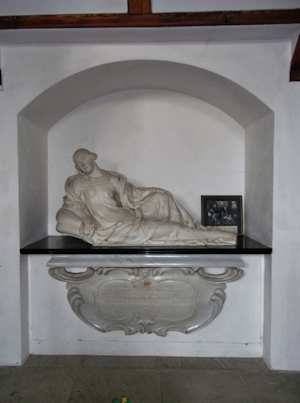
This project grew out of an unresolved question in Jude Jones' doctoral thesis, completed in 2013 (Jones 2013a). Part of Jones' research revolved around aspects of certain early modern tombs sited in Hampshire and Sussex parish churches, which she had been studying in some depth. However, the tomb in Mid-Lavant - the subject of this article and the model used - posed rather more questions than could be safely answered simply by documentary research, conventional photography and personal scrutiny. Later that year, Jones invited Gareth Beale, Nicole Smith and Yvonne Marshall to visit the Mid-Lavant tomb to test the potential for computational photographic techniques for analysis and interpretation of the tomb. Together, this team developed a methodology for the use of the technique of Reflectance Transformation Imaging (RTI) to examine particular details of the monument. Figure 1 shows the monument as it appears today.

Our article explores the ways in which performance of RTI in this context has contributed to conclusively revealing evidence of an object's material biography. This article will outline an argument for the use of RTI as part of a performance in which data are recorded and visualised through a process grounded both in materiality and sociality. In this way, RTI can be used to answer research questions that otherwise might be impenetrable. We will also address some of the pragmatic and theoretical questions posed by the use of this technique and explore the benefits of application of RTI as a method for visual analysis in archaeology. These are questions that Smith is currently evaluating in her research practice. The methodology used to interpret the Mid-Lavant tomb acknowledges assumptions about agency afforded to RTI as a form of capturing reality, as well as assumptions around autonomy (Pels et al. 2002), as part of processing results from RTI recording. This is discussed in detail throughout the article.
Thus, this essay has several inter-connected themes. Primarily it investigates the method of RTI and its technical and social utility when applied to objects that require considerable visual clarification. The potential for RTI as a method for discovery of new information is acknowledged by the team, but the impact of the inevitable black-boxing of the technological processes that enable RTI is discussed. In particular the algorithms that facilitate recording and extrapolation of light positions are outlined in relation to the impact on the presentation of RTI outputs using the conventions of photography. The performative nature of RTI as a social action that is impacted by the participants' own disciplinary praxis as a computational archaeology specialist and an early modern archaeologist and the inevitable selection within the practice of recording and processing, are described. Finally, the impact of projects such as the Mary May tomb on the social construction of RTI is discussed.
This article critically assesses the project methodology and the influence of theoretical standpoints on the application of interpretative methods during the project. This is enacted through the analysis of the Mary May tomb that follows. This analysis evaluates the possibilities that RTIs of the Mid-Lavant tomb have opened up for the creation of new knowledge about the object itself as well as contributing to understanding in the areas of archaeology, history of art, and ecclesiastical history.
Prefacing these discussions is a narration of the biography of the monument itself. This includes an examination of the narrative of Dame Mary May's tomb over the 339 years that have elapsed since it was set up in a small parish church in West Sussex. RTI has been instrumental in helping to define this story.
Internet Archaeology is an open access journal based in the Department of Archaeology, University of York. Except where otherwise noted, content from this work may be used under the terms of the Creative Commons Attribution 3.0 (CC BY) Unported licence, which permits unrestricted use, distribution, and reproduction in any medium, provided that attribution to the author(s), the title of the work, the Internet Archaeology journal and the relevant URL/DOI are given.
Terms and Conditions | Legal Statements | Privacy Policy | Cookies Policy | Citing Internet Archaeology
Internet Archaeology content is preserved for the long term with the Archaeology Data Service. Help sustain and support open access publication by donating to our Open Access Archaeology Fund.